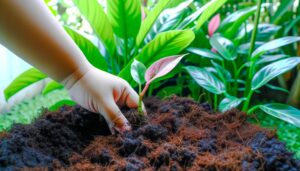Propagating Philodendron in Leca
Propagating Philodendron in LECA involves several meticulous steps. Begin by sterilizing pruning shears using a 70% isopropyl alcohol solution, then cut 4-6 inch stems with at least two nodes.
Soak pre-washed LECA in water for 24 hours and adjust the pH to 5.5-6.5. Place the cuttings in LECA making sure nodes contact the moist clay.
Maintain the water level just below the nodes and guarantee moderate airflow. Keep ambient temperatures between 18-24°C, with a relative humidity of 60-70% and indirect sunlight.
Consistent conditions are essential for successful propagation while additional intricate steps secure best results.

Key Takeaways
- Use sterilized pruning shears to cut 4-6 inch Philodendron stem segments with at least two nodes.
- Remove leaves from the lower nodes and optionally dip the cut end in rooting hormone.
- Rinse and soak LECA for 24 hours, then drain excess water to avoid root rot.
- Place cuttings in pre-soaked LECA, ensuring nodes are in contact with the moist clay balls.
- Maintain temperature between 18-24°C, relative humidity around 60-70%, and provide indirect sunlight or grow lights.
Gathering Your Supplies
To propagate philodendron in leca, begin by assembling the necessary supplies. These include a clean pair of pruning shears, a container with drainage holes, pre-washed lightweight expanded clay aggregate (leca), and a growth-promoting rooting hormone. Make sure the pruning shears are sterilized using a 70% isopropyl alcohol solution to prevent pathogen transmission.
Select a container with a minimum diameter of 15 cm to provide adequate space for root development. The leca should be thoroughly rinsed to remove any residual dust that could impede water absorption. Utilize a rooting hormone containing indole-3-butyric acid (IBA) for enhanced root initiation.
Accurate preparation of these materials is important for creating an ideal environment conducive to successful plant propagation.
Preparing the Cuttings
Verify the selected philodendron stem has at least two nodes, as these are essential points where roots and new growth will emerge.
Using sterilized pruning shears, make a clean cut just below a node. Make sure the cutting is approximately 4-6 inches in length to optimize nutrient absorption and stability.
Remove any leaves from the lower nodes to prevent decay when submerged in water.
Optionally, dip the cut end in rooting hormone to accelerate root development.
Allow the cutting to callus for 1-2 hours to minimize the risk of rot.
This preparation step is vital for ensuring successful propagation, as healthy, properly prepared cuttings establish more robust root systems in the subsequent stages of the process.
Setting Up the LECA
Begin by thoroughly rinsing the Lightweight Expanded Clay Aggregate (LECA) to remove any dust and debris that could hinder root development. This ensures that the LECA's porous surface remains ideal for water retention and aeration. After rinsing, soak the LECA in water for 24 hours to fully saturate the clay balls, which enhances their ability to provide consistent moisture to the plant roots.
| Step | Description |
|---|---|
| Rinsing | Remove dust to guarantee clean growing medium |
| Soaking | Saturate for 24 hours to enhance moisture retention |
| Draining | Remove excess water to prevent root rot |
| pH Adjusting | Test and adjust pH to 5.5-6.5 for optimal growth |
Carefully draining the LECA post-soaking is crucial to avoid waterlogging. Testing and adjusting the pH to a range of 5.5-6.5 will promote ideal nutrient uptake.
Planting the Cuttings
Place the prepared philodendron cuttings into the pre-soaked LECA, making sure that the nodes are in contact with the moist clay balls to facilitate root development.
Position each cutting so that at least one node is submerged within the LECA, maximizing exposure to the nutrient-rich water.
Maintain a spacing of approximately 2-3 centimeters between individual cuttings to prevent overcrowding and ensure sufficient air circulation.
Make sure the water level reaches just below the nodes without submerging them completely, promoting ideal oxygen exchange.
Utilize a container with drainage holes to manage excess water and prevent root rot.
This method allows the philodendron cuttings to establish strong root systems while minimizing the risks associated with traditional soil propagation methods.
Maintaining Proper Conditions
Ensuring ideal growing conditions for philodendron cuttings in LECA involves maintaining a stable temperature range between 18-24°C and relative humidity levels around 60-70%. Adequate light exposure is crucial, preferably indirect sunlight or artificial grow lights with a spectrum of 4000-6000 Kelvin. Consistent moisture levels in the LECA medium are essential to support root development, achieved by regularly checking and refilling the water reservoir.
| Condition | Optimal Range |
|---|---|
| Temperature | 18-24°C |
| Relative Humidity | 60-70% |
| Light Exposure | 4000-6000 Kelvin |
| Moisture Level | Consistently moist |
| Air Circulation | Moderate airflow |
Monitoring Growth and Adjustments
Monitoring the growth of philodendron cuttings in LECA involves regularly evaluating root development, foliage health, and moisture levels to make necessary adjustments for best plant health.
Assess root expansion bi-weekly, confirming roots are white and firm, indicating healthy growth.
Inspect foliage for chlorosis or necrosis, adjusting light exposure to 200-400 µmol/m²/s if discoloration occurs.
Monitor moisture levels by maintaining a water reservoir depth of approximately 2-3 cm, guaranteeing LECA remains consistently moist but not waterlogged.
Adjust nutrient solution concentrations to 1.0-1.5 mS/cm electrical conductivity (EC) to prevent nutrient deficiencies or toxicities.
Regularly aerate the root zone by gently agitating the LECA to enhance oxygen availability.
Implementing these practices guarantees optimal growth and minimizes stress.
Conclusion
To sum up, the careful cultivation of philodendron in LECA involves meticulous methods and measured maintenance. By gathering appropriate supplies, preparing precise cuttings, and setting up the LECA system, ideal conditions are established.
Ensuring environmental equilibrium and consistently monitoring growth parameters will foster flourishing philodendron propagation. This systematic approach underscores the significance of scientific scrutiny and sustained oversight in achieving successful plant proliferation.
Consequently, cultivating philodendron in LECA proves to be a precise, productive practice for plant propagation.






